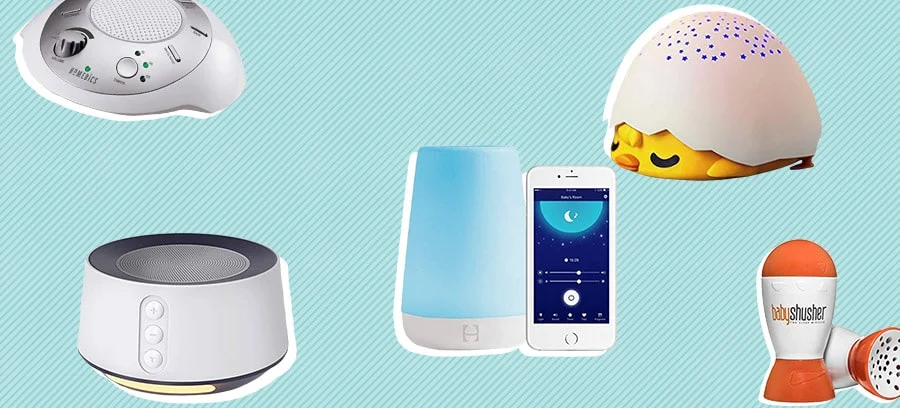
Parenthood can feel like one big blur of fatigue, especially in the early days when babies wake easily and often. Most parents will use anything they can to increase the quality and quantity of their sleep, and one tried and true method is using a noise machine. Long gone are the days of relying on TV static or the hum of a fan to drown out unpredictable sounds that might startle a sleeping child awake. White noise and other sound machines have been on the market since the 1960s but have grown in popularity.
However, in a recent news release regarding excessive noise and the risks to children’s hearing, the American Academy of Pediatrics (AAP) stated, “What families may not realize is that children are exposed to potentially harmful noise from infancy and that the effects are cumulative over a lifetime.” (1) They went on to warn against the use of noise machines, citing a recent study that sound machines are too loud and may damage hearing in the long term.
If you rely on a noise machine to catch a few precious extra minutes of sleep as a parent, not all is lost. Sound devices are still safe to use to help improve your baby’s sleep, so long as parents are following the recommended guidelines. “Most sound machines have volume controls, and parents can use an app to measure the volume and feel good about using white noise safely to help their baby sleep,” says Amy Motroni, Pediatric Sleep Consultant and member of the Association of Professional Sleep Consultants, and founder of The Postpartum Party.
What Do Noise Machines Do?
Noise and sound machines use sound frequencies to blend out other, more abrupt and disturbing sounds that can startle you awake or make it difficult to fall asleep. Most parents assume that muffled sounds of a heart beating or blood whooshing through veins are a soundscape that can re-create a comforting, familiar feeling once the baby is born.
White noise is the most well-known and used type for sleep machines. It is a constant sound of the full range of audible frequencies at the same intensities (just like white light is all the intensities of light). It can mask out surrounding noises and improve sleep quality. By increasing the acoustic threshold, brain stimulation lessens, and this promotes deeper sleep, according to one theory. Other studies show that white noise impacts the electrical activity in the brain, which leads to a faster time getting to sleep.
Noise machines often surpass the hearing-safe nursery maximum of 50 decibels recommended by the AAP, which is a level at which you can have a conversation at a typical volume.
Benefits and Risks of Using Sleep and Noise Machines
According to a 2022 study in BMJ Global Health (2), there is an urgent need to address hearing loss and noise exposure in children, with over a billion kids at risk as a direct result of too-loud sounds in their environments.
Unsafely loud sounds, whether experienced once or repeatedly over time, can harm your hearing. This damage can cause ringing in your ears, known as tinnitus, and can lead to changes in your ability to hear. Hearing loss and noise exposure have been linked to lower grades, less motivation, and trouble with concentration in kids. Plus, noise exposure earlier in life can make you more susceptible to age-related hearing loss, according to the study.
Despite the risks, sound machines can provide numerous benefits as long as they are used safely, according to Matroni.
- The womb was noisy, and for newborns, white noise can be very calming and help recreate a womb-like environment.
- White noise helps block out outside noises that might wake up your baby otherwise, such as pets, street noise, or older siblings.
- White noise makes naps easier on the go or in unfamiliar places. A sound machine can create a positive sleep association to help cue your baby’s brain that it’s time for sleep.
- White noise can help babies transition between sleep cycles and have more restorative sleep.
Other types of sound machines are also available, including smart noise machines that use structured sounds for varying kinds rather than just one, which may have harmful side effects on cognition, though more research is needed.
The AAP acknowledges that noise machines can help with sleep and recommends pediatricians counsel parents who use infant sleep machines or noise machines about safe use. If you currently use one, consider asking your doctor for advice.
Other Ways to Improve Sleep Quality Without Noise Machines
There are plenty of ways to improve your baby’s sleep quality if you don’t want to use white noise, according to Motroni. “Create an optimal environment for sleep by ensuring your baby’s room has a cave-like darkness,” she says. Motroni recommends blackout curtains and avoiding nightlights for babies and newborns.
Ensuring the bedroom is not too warm is also essential. Before drifting off to sleep, core body temperature drops naturally, and being overly hot can prevent this. Dress your baby appropriately for slumber, such as in a non-weighted sleep sac, without any blankets or loose bedding. Most babies sleep best in a cool environment of between 68 and 72 degrees, according to Matroni.
It’s also important to pay attention to your baby’s wake windows and avoid overtiredness throughout the day. A well-rested baby will typically sleep better at night, too, says Matroni. Ideally, newborn babies should be awake for about an hour before bed to prevent overstimulation and, by nine months, should be down for the night by 7 p.m., waking 11 to 12 hours later.
Keep in mind that babies do tend to sleep through the night eventually, typically by six months, though some may take longer. It may help to know that if your baby doesn’t sleep well, it’s not likely to cause harm. Doing your best to set your baby up for healthy hearing and sleep is enough; if you have any concerns about either, consult with your pediatrician.
Sources
1. American Academy of Pediatrics, “American Academy of Pediatrics Sounds the Alarm on Excessive Noise and Risks to Children’s Hearing in Updated Policy Statement,” https://www.aap.org/en/news-room/news-releases/aap/2023/american-academy-of-pediatrics-sounds-the-alarm-on-excessive-noise-and-risks-to-childrens-hearing-in-updated-policy-statement/; October 21, 2024.
2. Dillard LK, Arunda MO, Lopez-Perez L, et alPrevalence and global estimates of unsafe listening practices in adolescents and young adults: a systematic review and meta-analysisBMJ Global Health 2022;7:e010501.
Motroni, Amy. Author interview. October 2024.


























